When and how to plant tulips: basic rules and mistakes
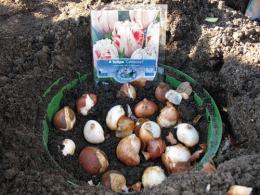
Despite the fact that the flowering period of tulips is short and we have to decide how to fill the quickly empty space in the flowerbed, they never cease to be popular. Today there are almost three thousand varieties of tulips that can satisfy the taste of the most demanding gardener.
Content:
- The most suitable period for planting tulips
- Rules for planting tulip bulbs
- Mistakes when planting tulips and how to avoid them
The most suitable period for planting tulips
Optimal landing period The tulip season starts from mid-September and continues until the end of October. Adjustments should be made for certain regions: in the north, planting should be done at the beginning of September; in the south, planting can be postponed until the end of October. To correctly determine the time for planting tulips in a certain region, it is enough to know the optimal soil temperature.
Tulips are planted when the temperature at a depth of about ten centimeters does not exceed ten degrees Celsius. Planted in warmer soil, the flowers will have time to germinate before winter, but will not bloom in the spring. Later planting will not give the opportunity to take root before frost.
Rules for planting tulip bulbs
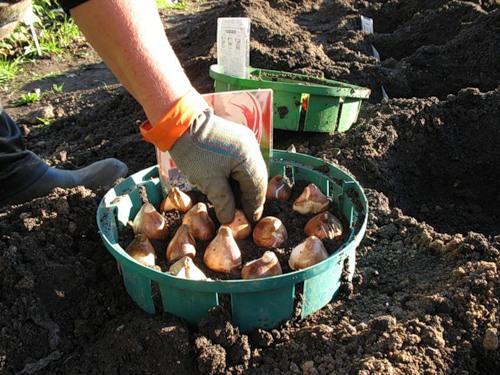
You can grow elite and most capricious varieties of tulips in the garden by adhering to simple rules for planting them:
- Choosing a landing site. Tulips prefer a sunny place. They bloom in partial shade if the soil is sufficiently fertilized and loose.Plants do not like strong, sharp winds. If the place where you plan to have a flower bed with tulips is prone to moisture stagnation, sand or fine gravel should be poured into the bottom of the holes or furrows. It will provide natural drainage and will not allow the bulbs to rot.
- Soil preparation. It is advisable to plant plants in a bed with light sandy loam soil. The land should be ready by the end of August. It needs to be dug up to the depth of a shovel, fertilize with humus, compost and superphosphate. Fresh manure is contraindicated as it causes fungal diseases or rotting of the bulbs. Tulips absorb nutrients in close proximity to the root system, so superphosphate can be added when planting under each bulb. It will be useful to add wood ash in the proportion of a glass per square meter. Too dense soil can be lightened by adding sand.
- Selection of bulbs. If the planting material has not grown in your own flowerbed and you need to purchase it, it is best to do this immediately after digging it up. This is the end of July, beginning of August. After spending money on bulbs, the gardener will make sure that they are properly stored before planting in the ground. After lying for several months in a warehouse or store shelf, where the microclimate is not always appropriate, they can dry out and die.
- The planting material must be dense, evenly colored, without visible stains or mechanical damage, and well dried. Before planting, the bulbs need to be soaked for about two hours in a weak solution of potassium permanganate. If there is no time for prevention, just pour this potassium permanganate into the planting holes. Large bulbs and children should be planted separately from each other. Children planted in autumn will not bloom yet next year.
- Planting depth. Depends on the bulb and is approximately three times its size. This is approximately 10–15 centimeters for large bulbs, 5–7 for children. Bulbs can be planted either in holes or in furrows. With the second planting option, you should choose planting material of the same size for each individual groove. For tulip bulbs, it is very important to maintain the correct planting depth, and with their different sizes, the depth of the groove is almost impossible to determine.
- Distance between bulbs when planting. Depends on the size of the bulb itself. Usually it is about 10–15 centimeters. Children can be planted more closely together. If planting is done in rows, then the distance between them is 30–35 centimeters. It is not necessary to take a tape measure with you to the garden: this distance is equal to the height of a bayonet shovel.
- Watering. Before planting, the prepared holes or grooves must be thoroughly watered. You can water the plants after planting to help the soil better cover the bulbs. But first you need to level the ridge with a rake so that water does not accumulate in the recesses.
- Preparing for winter. Although tulips are perennial plants, which means they are adapted to wintering, they should be covered if the winter is going to be cold. For these purposes, humus, peat, and fallen leaves are used. In addition, under such a “fur coat” the earth will not crack during temperature changes, and the temperature itself will be more even, which has a beneficial effect on plant growth.
Mistakes when planting tulips and how to avoid them

Tulips are enough unpretentious plants, but some mistakes when planting can leave gardeners in the spring without their flowering:
- Planting dates are too late. A plant planted late will not have time to prepare for winter and take root.It will most likely enter spring sick and will not bloom, or this will happen much later. If the tulip “delays” the beginning of flowering until June, then you may not admire the flowers. The peculiarity of this plant is that at temperatures above 25 degrees, the growing season stops and the flower stalks die.
- Incorrect planting depth. It is very important to maintain the required planting depth. If the bulb is higher than the required depth, it may not survive the winter cold. Burying deeper may result in the plant being late in the growing season in the spring.
- Planting diseased or damaged bulbs. Planting material must be in perfect condition. If tulips were not purchased, but grown and dug in your own garden, you should carefully examine each bulb. If there are doubts about its quality and health, you need to throw away such material without pity. A diseased bulb will not decorate the flower garden, but will only harm it, infecting all other planting material.
Breeders bred a large number of varieties different flowering periods: early flowering, medium flowering and late flowering. Selecting different varieties of plants will extend the flowering period for several weeks.
Watch how to plant tulips correctly in the video:
Interesting information about the vegetable garden

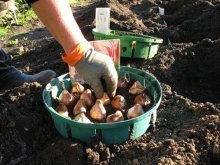
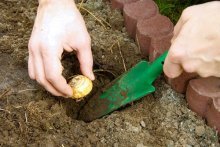


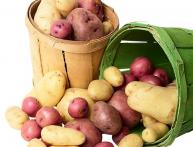


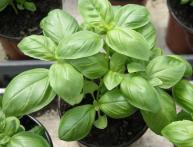


Comments
At the end of August it is worth planting tulips. This is a fact, regardless of other recommendations. We have been growing these flowers in our dacha for many years now and not a single year has there been a small “harvest”. You just need to plant them more often.
When do you dig them up? As soon as they bloom or after the leaves begin to fade? and what to do with the bulbs until they need to be planted in the ground again?